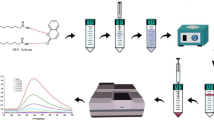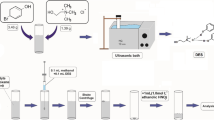Abstract
As extraction solvents, ionic liquids have green characteristics. In this study, an environmentally benign analytical method termed temperature-controlled ionic liquid dispersive liquid phase microextraction (TIL-DLME) combined with ultra-highpressure liquid chromatography (UHPLC)-tunable ultraviolet detection (TUV) was developed for the pre-concentration and determination of triclosan (TCS), triclocarban (TCC) and methyl-triclosan (M-TCS) in water samples. Significant parameters that may affect extraction efficiencies were examined and optimized, including the types and amount of ionic liquids, volume of the diluent, heating temperature, cooling time, salt effect and pH value. Under the optimum conditions, linearity of the method was observed in the ranges of 0.0100–100 μg L−1 for TCS and M-TCS, and 0.00500–50.0 μg L−1 for TCC with correlation coefficients (r 2) > 0.9903. The limits of detection (LODs) ranged from 1.15 to 5.33 ng L−1. TCS in domestic water and TCC in reclaimed water were detected at the concentrations of 1.01 and 0.126 μg L−1, respectively. The spiked recoveries of the three target compounds in reclaimed water, irrigating water, waste water and domestic water samples were obtained in the ranges of 68.4%–71.9%, 61.6%–87.8%, 58.9%–74.9% and 64.9%–92.4%, respectively. Compared with the previous dispersive liquid-liquid microextraction method (DLLME) about the determination of TCS, TCC and M-TCS, this method is not only more environmentally friendly but also more sensitive.
Similar content being viewed by others
References
Liu JF, Jiang GB, Chi YG, Cai YQ, Zhou QX, Hu JT. Use of ionic liquids for liquid-phase microextraction of polycyclic aromatic hydrocarbons. Anal Chem, 2003, 75: 5870–5876
Schrekker HS, Stracke MP, Schrekker CML, Dupont J. Ether-functionalized imidazolium hexafluorophosphate ionic liquids for improved water miscibilities. Ind Eng Chem Res, 2007, 46: 7389–7392
Zhou QX, Bai HH, Xie GH, Xiao JP. Trace determination of organophosphorus pesticides in environmental samples by temperature-controlled ionic liquid dispersive liquid-phase microextraction. J Chromatogr A, 2008, 1188: 148–153
Kulkarni PS, Branco LC, Crespo JG, Afonso CAM. Capture of dioxins by ionic liquids. Environ Sci Technol, 2008, 42: 2570–2574
Xiong J, Hu B. Comparison of hollow fiber liquid phase microextraction and dispersive liquid-liquid microextraction for the determination of organosulfur pesticides in environmental and beverage samples by gas chromatography with flame photometric detection. J Chromatogr A, 2008, 1193: 7–18
Bai HH, Zhou QX, Xie GH, Xiao JP. Enrichment and sensitive determination of dichlorodiphenyltrichloroethane and its metabolites with temperature controlled ionic liquid dispersive liquid phase microextraction prior to high performance liquid phase chromatography. Anal Chim Acta, 2009, 651: 64–68
Vidal L, Chisvert A, Canals A, Salvador A. Sensitive determination of free benzophenone-3 in human urine samples based on an ionic liquid as extractant phase in single-drop microextraction prior to liquid chromatography analysis. J Chromatogr A, 2007, 1174: 95–103
Vidal L, Psillakis E, Domini CE, Grané N, Marken F, Canals A. An ionic liquid as a solvent for headspace single drop microextraction of chlorobenzenes from water samples. Anal Chim Acta, 2007, 584: 189–195
Ye CL, Zhou QX, Wang XM, Headspace liquid-phase microextraction using ionic liquid as extractant for the preconcentration of dichlorodiphenyltrichloroethane and its metabolites at trace levels in water samples. Anal Chim Acta, 2006, 572: 165–171
Abulhassani J, Manzoori JL, Amjadi M. Hollow fiber based-liquid phase microextraction using ionic liquid solvent for preconcentration of lead and nickel from environmental and biological samples prior to determination by electrothermal atomic absorption spectrometry. J Hazard Mater, 2009, 176: 481–486
Baghdadi M, Shemirani F. Cold-induced aggregation microextraction: A novel sample preparation technique based on ionic liquids. Anal Chim Acta, 2008, 613: 56–63
Liu Y, Zhao EC, Zhu WT, Gao HX, Zhou ZQ. Determination of four heterocyclic insecticides by ionic liquid dispersive liquid-liquid microextraction in water samples. J Chromatogr A, 2009, 1216: 885–891
Pena MT, Casais MC, Mejuto MC, Cela R. Development of an ionic liquid based dispersive liquid-liquid microextraction method for the analysis of polycyclic aromatic hydrocarbons in water samples. J Chromatogr A, 2009, 1216: 6356–6364
Wu YL, Xia LB, Chen R, Hu B. Headspace single drop microextraction combined with HPLC for the determination of trace polycyclic aromatic hydrocarbons in environmental samples. Talanta, 2008, 74: 470–477
Li SQ, Cai S, Hu W, Chen H, Liu HL. Spectrochim Acta, Part B, 2009, 64: 666–671
Panagiotou AN, Sakkas VA, Albanis TA. Application of chemometric assisted dispersive liquid-liquid microextraction to the determination of personal care products in natural waters. Anal Chim Acta, 2009, 649: 135–140
Coogan MA, Edziyie RE, La Point TW, Venables BJ. Algal bioaccumulation of triclocarban, triclosan, and methyl-triclosan in a North Texas wastewater treatment plant receiving stream. Chemosphere, 2007, 67: 1911–1918
Singer H, Muller S, Tixier C, Pillonel L. Triclosan: Occurrence and fate of a widely used biocide in the aquatic environment: field measurements in wastewater treatment plants, surface waters, and lake sediments. Environ Sci Technol, 2002, 36: 4998–5004
Halden RU, Paull DH. Co-occurrence of triclocarban and triclosan in U.S. water resources. Environ Sci Technol, 2005, 39: 1420–1426
Ying GG, Yu XY, Kookana RS. Biological degradation of triclocarban and triclosan in a soil under aerobic and anaerobic conditions and comparison with environmental fate modelling. Envir Pollut, 2007, 150: 300–305
Guo JH, Li XH, Cao XL, Li Y, Wang XZ, Xu XB. Determination of triclosan, triclocarban and methyl-triclosan in aqueous samples by dispersive liquid-liquid microextraction combined with rapid liquid chromatography. J Chromatogr A, 2009, 1216: 3038–3043
Li YY, Wei GH, Hu J, Liu XJ, Zhao XN, Wang XD. Dispersive liquid-liquid microextraction followed by reversed phase-high performance liquid chromatography for the determination of polybrominated diphenyl ethers at trace levels in landfill leachate and environmental water samples. Anal Chim Acta, 2008, 615: 96–103
Zhou QX, Bai HH, Xie GH, Xiao JP. Temperature-controlled ionic liquid dispersive liquid phase micro-extraction. J Chromatogr A, 2008, 1177: 43–49
Baghdadi M, Shemirani F. In situ solvent formation microextraction based on ionic liquids: A novel sample preparation technique for determination of inorganic species in saline solutions. Anal Chim Acta, 2009, 634: 186–191
Erickson BE. Methyl triclosan found in Swiss lakes. Environ Sci Technol, 2002, 36: 228A–230
Author information
Authors and Affiliations
Corresponding authors
Rights and permissions
About this article
Cite this article
Guo, J., Li, X., Cao, X. et al. Temperature-controlled ionic liquid dispersive liquid phase microextraction combined with ultra-high-pressure liquid chromatography for the rapid determination of triclosan, triclocarban and methyl-triclosan in aqueous samples. Sci. China Chem. 53, 2600–2607 (2010). https://doi.org/10.1007/s11426-010-3169-y
Received:
Accepted:
Published:
Issue Date:
DOI: https://doi.org/10.1007/s11426-010-3169-y




